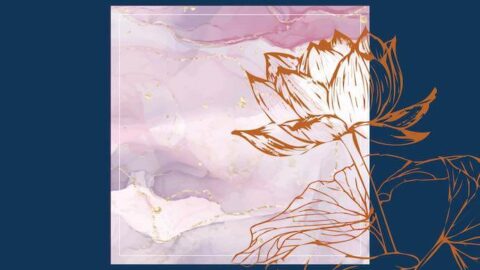As an avid record collector, I have a pretty strong ability to pick albums off the shelf that look like they might be worth hearing. Sure, they say you shouldn’t judge a book by its cover, but there is often something more precise about the artwork of an album that communicates the character of what you might find when the needle hits the groove.
In the case of composer and bandleader Yu Nishiyama’s debut release, A Lotus in the Mud (out May 20, 2022 via Outside In Music’s up-and-coming jazz imprint, Next Level), the album cover shows a blue-grey field overlaid with a rust-colored line drawing of a lotus flower. In the center is a dreamy, pastel blur divided into quadrants by golden fractures reminiscent of kintsugi, the Japanese art of repairing broken ceramics with golden lacquer.
For Nishiyama, who grew up in Yokohama, Japan, the symbol of the lotus is a familiar cue taken from Japanese Buddhist culture. The album’s title is inspired by the Japanese saying, deichu no hachisu, or: ‘a lotus blooms better if the mud is dirtier.’ Nishiyama’s journey from studying classical saxophone as a teenager, transitioning to jazz, and ultimately relocating to the US brings this imagery beautifully to life. “I really wanted to play with people,” she says. “There are not many ways to do that in classical music – the saxophone is considered niche and not usually a part of the orchestra.” In developing the content of A Lotus in the Mud, Nishiyama has turned inward to explore both her Japanese heritage and her experience as a Japanese-American transplant in pursuit of new opportunities to make music.

The opening few bars of the first track, Retrospections, sound like sequenced electronic samples before a smooth vamp emerges, signaling that we are listening to tightly crafted live music. Various influences cited by Nishiyama herself are quite apparent, such as the swing of Count Basie and her reimagining of Hoagy Carmichael’s iconic Skylark as a peppy samba reminiscent of Carlos Jobim. Still, there is a distinctly Japanese character to the work in its orderly exposition and clear dedication to craft, function, and the throughline it draws out of established traditions. I couldn’t help but draw stylistic parallels with iconic film and television composers such as Yoko Kanno (perhaps best known for her incredible contribution to Cowboy Bebop). I was also reminded of the 1950s and 60s film scores of Masaru Sato, a frequent collaborator of legendary Japanese filmmaker Akira Kurosawa.
The album’s second cut, Time is Money, “a frustrated rant about adjusting from the precise, punctual culture of the Tokyo suburbs to the more relaxed approach to the clock that [Nishiyama] discovered in Texas,” particularly channels this cinematic flavor. There is a kinetic fervor to this piece that immediately brings images to mind of busy streets and the bustling activity the composer aims to criticize. In contrast, I can’t imagine a happy life without you is Nishiyama’s first attempt at writing a love song, though as the composer remarks, she is “hoping it will be my last.” A swanky, vintage dancehall vibe complements the implications of a love song, while the mysterious tonality and rambling cadence in the thematic head infuse a sense of emotional complexity.
The direct and honest clarity in the formation and expression of Nishiyama’s ideas suggests the cultivation of the eponymous lotus, though at times I was hoping to experience a little more mud. This particularly in Honorary Whites, the composer’s meditation on the struggles she has faced due to perceptions in the United States of the Asian model minority.

Nishiyama writes, “I came to the United States and experienced discrimination myself…not only the struggle or fear of not being accepted, but also my feelings of rage, jealousy, and sadness towards white supremacy…the message is delivered via the alto saxophone solo as it goes through bi-tonal harmony, which ends in disharmony.”
Saxophonist Adam Hutcheson riffs out some excellent material on this track. Still, after an ominous introduction, I found myself yearning for a more chaotic exposition. An upbeat-if-melancholy theme glides out of the alto sax, overlapped by a recurring motif of stacking, dissonant chords first heard in the repeating four-bar intro. The dichotomy of anger and frustration pitted against the expectation of the model minority to “set a good example” is effectively communicated through this conflicted structure, but it feels unresolved, without one ever overcoming the other.
The album’s title track, A Lotus in the Mud, remains in this well-ordered space. The track opens in an ambient haze that is sliced open by a pensive melody. Right around the 1:40 mark, the full band bursts to life across two solo breaks played skillfully on sax by Alex De Lazzari and trumpet by David DiTrapani. Composers like Henry Mancini and Lalo Schifrin come to mind, and the piece proceeds with a vibe that pays clear homage to Nishiyama’s historic influences.
Overall, I had a ton of fun listening to this album from end-to-end and have found myself returning to each track and departing again possessed by countless earworms. Nishiyama is a great ascending talent who leaves a lot to look forward to, especially as she continues to muddy the waters in which her proverbial lotus is blossoming.
I CARE IF YOU LISTEN is an editorially-independent program of the American Composers Forum, funded with generous donor and institutional support. Opinions expressed are solely those of the author and may not represent the views of ICIYL or ACF.
A gift to ACF helps support the work of ICIYL. For more on ACF, visit the “At ACF” section or composersforum.org.
























